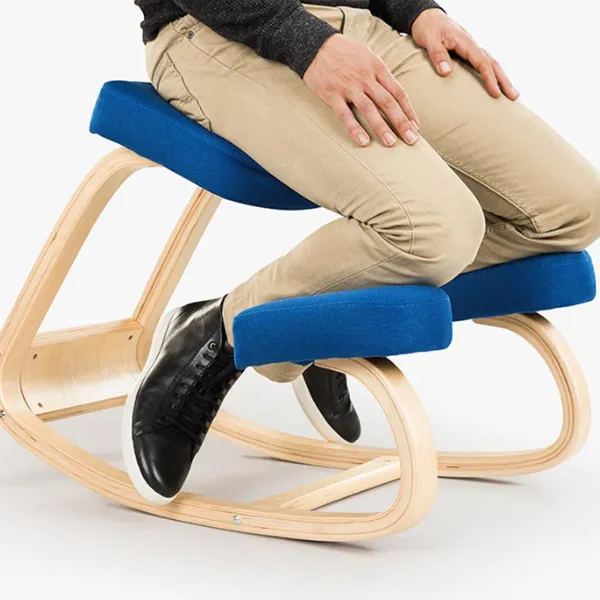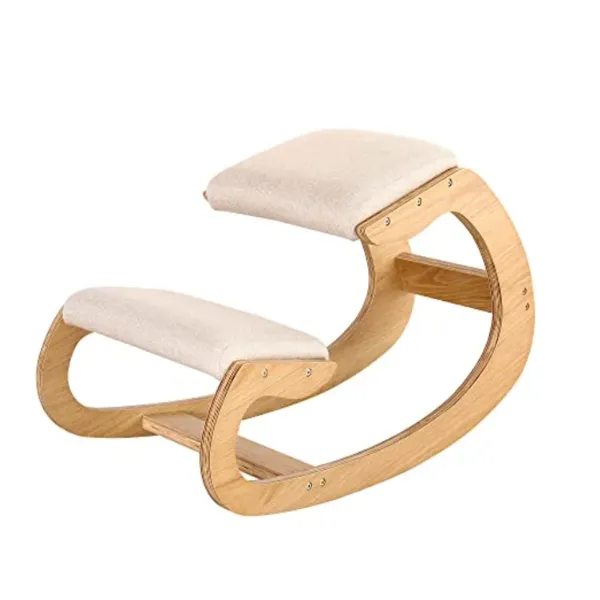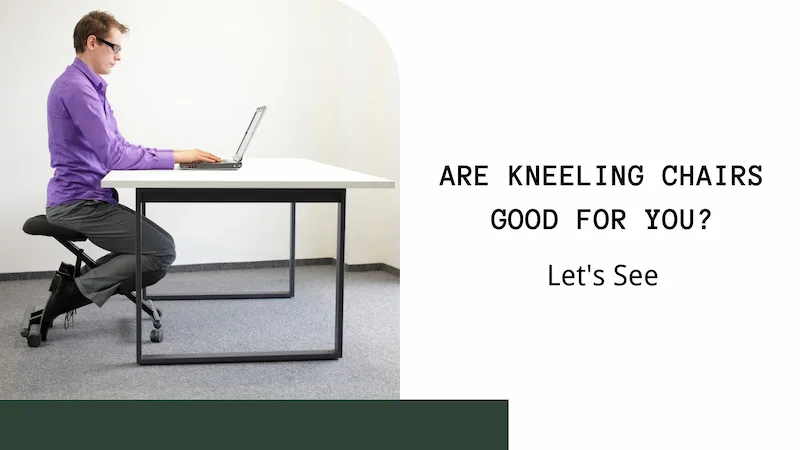You might develop musculoskeletal problems if you sit still and slouched for eight hours a day, five days a week, for a full year. How about kneeling chairs? Are kneeling chairs good for you?
Yes, kneeling chairs are good for you. Generally speaking, kneeling chairs can improve your posture, relieve pressure on your low back, and short-term fatigue.
To improve spinal alignment, the kneeling chair tilts the pelvis forward. They ought to only be used for two hours at a time because of the decreased knee pressure and spinal rotation.
Please read on for more detailed information.
What Are Kneeling Chairs?
Based on designs by Peter Opsvik, kneeling chairs first gained popularity as an alternative to office chairs in the 1970s. In an effort to lessen the frequent aches and pains that so many office workers experience worldwide, they offer an alternative way to sit.
The design’s goal is to balance the pelvis and, by extension, the spine in a poised, natural position with an open hip angle by angling one seat forward. Good kneeling chairs have knee pads, but they are not always needed because the legs can take on different positions. Shin pads, however, can keep the body from slipping forward. Your postural muscles will be encouraged to better align your back, shoulders, and neck in this “kneeling” position. Kneeling chairs that have a rocking seat stimulate variety and are best for longer usage.
Are Kneeling Chairs Good for You?
There will never be a single ideal chair for everyone because we are all unique and perform a variety of tasks at various workstations. One thing health professionals agree on is that moving regularly is good for you. Many thousands of users will attest that switching to a rocking, swivelling kneeling chair is a fantastic way to encourage more movement. Here’s why:
- It releases pressure on your body and helps you get out of static positions that cause your body to move more slowly.
- You won’t be able to sit still for very long. Sitting still slows the metabolism, which reduces the body’s ability to regulate blood sugar and break down body fat.
Introducing a rocking kneeling chair as a seating option in the office is a good way to encourage more movement. Rocking kneeling chairs are designed to promote ‘active sitting‘ and in many situations this encourages more core activity.
Rocking kneeling chairs can be used all day by most people after acclimatisation. On the other hand, static kneeling chairs don’t stimulate the user and are best used for quick tasks.
For computer work and other tasks that might otherwise keep you seated, as well as for work that requires leaning forward, like handwriting or drawing, rocking kneeling chairs are ideal. A desk slope could be added for these.
As with all chairs, it’s vital that your kneeling chair works well with your other working furniture and equipment, to achieve a good set up and encourage movement. A quality rocking kneeling chair is built to last, has adjustments for different body types and surface heights, as well as a swivel and wheels for mobility. It offers the necessary adjustment and movement options to keep you moving all day long, with periodic breaks of course.

How is Your Body Posture Benefited When Using a Kneeling Chair?
- Your pelvis is tipped forward when you use a kneeling chair. This prevents you from hunching forward and curving your spine into a C-shape, which is necessary to maintain proper spinal alignment.
- This type of pelvic opening while seated in a knee chair will help to improve your breathing because of the right posture. When the pelvis is open, your internal organs are less compressed, which enhances digestion.
- When you sit on a kneeling chair, you gradually strengthen your back and core muscles. The strengthening happens because the chair requires you to engaged your abdominal and back muscles because most kneeling chairs don’t come with backrests (although check out our Tokyo modelif you’re not ready to get rid of the backrest completely). Keep in mind that it’s completely normal to feel discomfort and need to take frequent breaks at first. Your body will likely need some time to get used to this new way of sitting and to strengthen.
- The kneeling chair provides an angle of 10 degrees between the trunk and the thighs, as opposed to the traditional right angle chair’s usual 90 degrees. When you sit at this angle, the pressure on the disc in your spine is lessened, and your lumbar (lower) spine is greatly relieved.
- Using a kneeling chair causes your hips to slide forward. As your weight is distributed evenly and your neck, shoulders, and back are in alignment, the forward angle is crucial. As a result, your lower back is less stressed, spinal compression is avoided, and your shoulders are kept naturally rolled back and down, providing relief for your upper spine and neck as well.
- You have the choice to change the seat height on some kneeling chair models. This implies that you change the slope. By doing this, you can regulate the force applied to your shins. Check out our Alpharetta, Atlantaand Tokyo models if you’re looking to be able to customize the kneeling chair to your body’s needs.
- When you’re working, pain can be a major deterrent. You lose concentration, your output drops, and you might even start to dread sitting at your desk. Working in a kneeling chair forces you to keep your spinal column upright. Since you have better circulation, your brain receives nutrients that help you concentrate while working as your core muscles become active. No pain, more gain!
- We advise switching between your regular chair, which your body is accustomed to, and your new ergonomic kneeling chair when you first start using a kneeling chair full-time.
It has been demonstrated that kneeling chairs are a superior replacement for the conventional right angle chair. We get a lot of questions about our rocking balancing kneeling chairs. Many of you are uncertain about whether or not this kind of kneeling chair is appropriate for full-time work and whether or not you will find them distracting all day.
To be clear, all of our kneeling chairs are made to be used all day (although we recommend getting up and moving around every hour to get those steps in!).).
Read about
Is It Healthier to Kneel Or Sit?
Your health could be harmed by spending a lot of time sitting down. There is evidence that long periods of sitting reduce health risks. They also support deeper breathing, increase blood circulation, lessen chronic pain in the arms and hands, and strengthen your neck and back. Kneeling chairs are a great short-term seating option if you want to enhance your general health and wellbeing.

How Long Should You Sit in Kneeling Chair?
I usually advise my patients to begin with brief sessions no longer than fifteen minutes when using a kneeling chair for the first time. Your body will adjust to the new position more easily and there will be less chance of pain or discomfort. You can gradually extend the amount of time you spend in the chair as you get used to it. To stretch your legs and prevent stiffness, it’s important to take breaks every 20 minutes. The best posture is always one that is in motion, always!
It’s not advised for most people to sit in a kneeling chair for longer than two hours at a time. In addition to reducing leg circulation, prolonged use can also hurt the shins. A kneeling chair can also be challenging for some people to get in and out of. Utilizing this chair correctly requires paying attention to your body and taking breaks.
If you ask us, the quality of a roaring fire depends entirely on the chair you are sitting in. The best fire pit chairs are the ones you can curl up in for hours on end, whether you’re roasting marshmallows on a warm summer night or wrapped up in a blanket on a brisk fall morning.
What is the Proper Way to Use a Kneeling Chair?
The first time you sit in a kneeling chair, it might feel strange or immediately wonderful. A gradual strengthening of muscles is frequently the best approach for many people, as it is for any new activity. You may find that keeping your existing office chair nearby and alternating between the two will help in the transition. A rocking kneeling chair gradually strengthens your core muscles over the course of days and weeks, but your body will need time to adjust if you’ve been sitting incorrectly or simply in a different position.
Your bottom should support the majority of your weight when using a kneeling chair. The lower pad acts as support for your shins to prevent the sensation of sliding forward. Start by sitting on the seat, then kneel down and place your knees gently (or just above) the pads. It’s important to switch positions frequently while working, and the rock and swivel will help with some of this movement. It’s a good idea to switch up which leg comes forward.
Do Kneeling Chairs Hurt Knees?
Kneeling chairs, according to some experts, can cause joint pain, particularly in the knees. This is due to the fact that sitting in a kneeling chair limits your ability to move your legs. As a result, the shins may experience pressure and eventual pain. Kneeling chairs can also restrict blood flow to the legs, which can be uncomfortable for those who have circulation problems. Finally, getting in and out of a kneeling chair can be challenging, especially if you have any mobility issues.
Final Words: Are Kneeling Chairs Good for You?
It has been demonstrated that using kneeling chairs can improve posture, ease low back pain, and temporarily reduce fatigue. If you’re looking for an alternative to sitting in a traditional chair all day, a kneeling chair might be a good choice. It is important to remember, though, that using them for longer than two hours at a time could cause long-term harm. Have you ever sat in a chair that is kneeling? How would you describe your experience?



